City of Canning Wharf St Basin
Key achievements
- A WA-first smart park
- Over 70 local native species
- The park is being used by a diverse cross-section of the community
Stormwater basins manage stormwater runoff and play an important role in keeping waterways healthy. They collect surface water after rain, which frequently contains nutrients from dog poop, fertilisers, grass clippings, detergents, and oils from driveways and roads. Stormwater basins help to improve water quality by filtering pollutants before they enter the environment.
Perth has hundreds of stormwater basins. They used to be fenced in and an eyesore for some, but many are now being transformed into vibrant community spaces, with the City of Canning leading the way.
Innovation in the City of Canning
The City of Canning transformed a fenced-off stormwater basin in Cannington into a community smart park. Funding partners from the Australian Government's Smart Cities and Suburbs Program, Water Corporation, and the Department of Water and Environmental Regulation collaborated on the project.
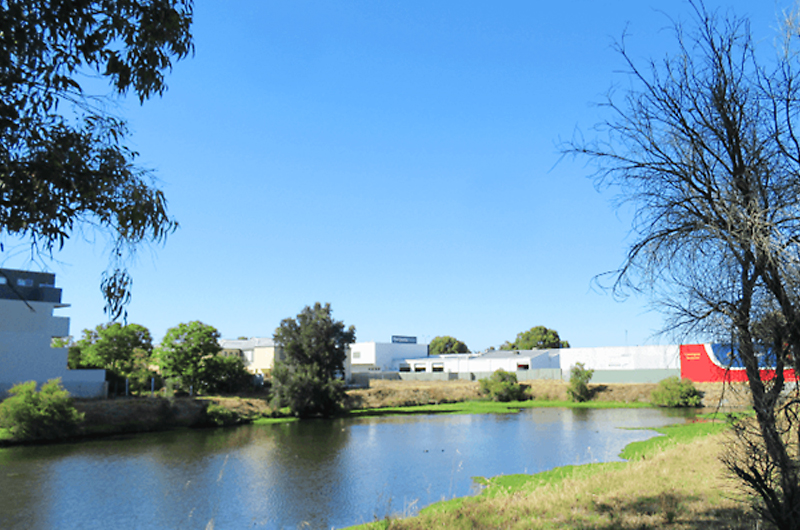
Wharf St Basin Next Generation Community Park stormwater basin before its transformation.
What is a smart park?
A smart park uses technology to:
- improve the efficiency of resources like water, energy and waste management
- reduce environmental impacts
- enhance the quality of life and well-being of the community
The Canning City Centre Regeneration Program recognised early on that there was a lack of public open space within the City Centre. Over the next 20 years, the City Centre is expected to accommodate 10,000 new homes for up to 25,000 residents. The Wharf Street Basin site was identified as a potential development for public open space.
Funding assistance through the Australian Government’s Smart Cities and Suburbs Program allowed for Smart Cities thinking to be embedded into this project. By incorporating innovative landscape design with smart city technology, we’ve created a recreational space at the Wharf Street Basin that utilises a new approach to stormwater management.
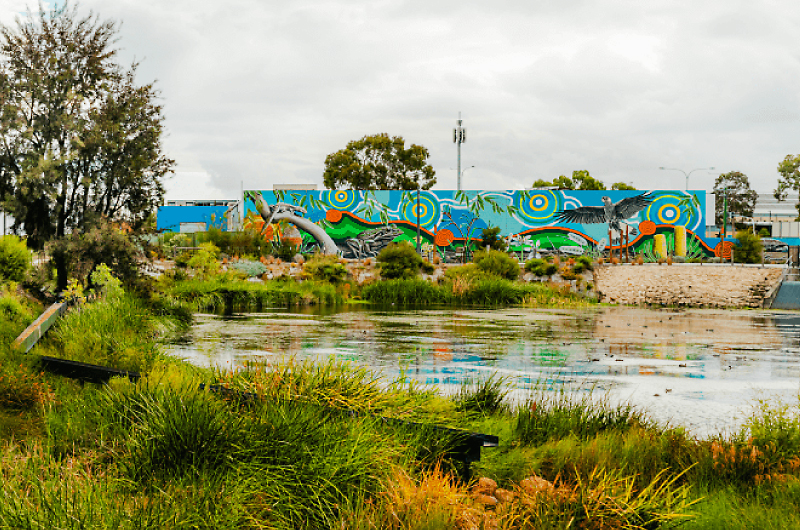
Wharf St Basin Next Generation Park – stormwater basin transformed. Image credit: Danika Zuks
Key areas of change
A WA first, the smart park is an innovative example of how stormwater basins can be transformed into multipurpose spaces that benefit the environment and community.
Biodiversity has increased markedly. The site previously contained only 3 native plant species, while after redevelopment, over 70 local native species can be found. This adds to flora diversity and habitat availability and provides food sources for fauna. The plants also play a key role in improving water quality outcomes.
The park is now being used by a diverse cross-section of the community, who are using the site for a range of recreational and social activities. The site design has created a place that people visit, walkthrough, stroll around, use for exercise and come to experience a natural space amongst a busy urban centre.
The educational purpose of the site is also being fulfilled. Visitors interact with the site's digital elements and are attracted to the informational signage. Organised visits and tours of the site, interest from schools and tertiary programs, and connections to non-government, community and professional groups demonstrate ongoing learning enabled by the project.
This pilot project has taken home 18 awards, both at a local and national level.
Mayor Patrick Hall said Wharf Street Basin Next Generation Community Park is one of the centrepieces of urban renewal and innovation in the City of Canning.
“Wharf Street Basin is one of the City’s most successful pilot programs, and it shows through the variety and volume of awards it has won at both state and national levels.
“This project is an innovative collaboration between the City of Canning and WA’s thought leaders and key government agencies in water research, technology, urban redevelopment and landscape architecture, who have worked towards striking a balance between recreational space and stormwater management.
“We now have a project framework that can be a model for all of WA and even Australia – and it started here at the City of Canning.”
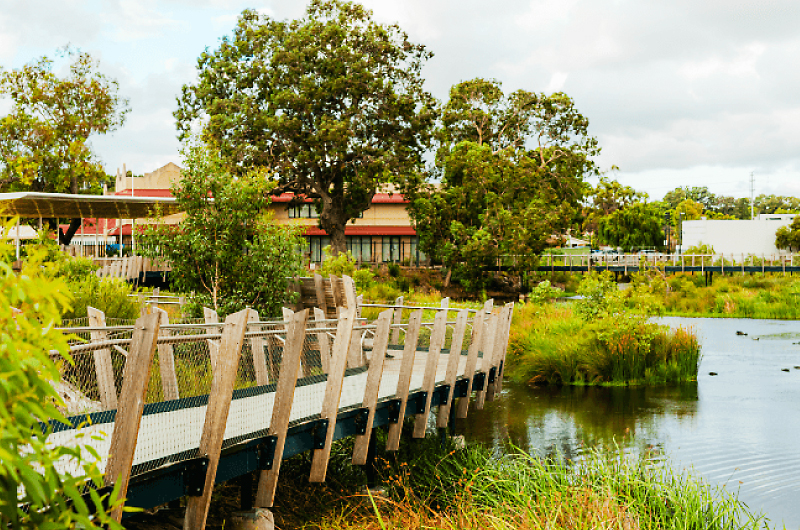
The walkway bridge at Wharf St Basin Next Generation Park. Image credit: Danika Zuks
How we did it
We reached out to landscape architects Josh Byrne & Associates to develop a concept for the park, and Environmental Industries constructed the park. Using smart design and technology solutions, environmental data and considering community needs, the design included:
- landscape design to enhance the natural environment
- interactive augmented reality education stations through the creation of the Smart Canning app
- a bridge for pedestrians to access Cecil Avenue from Wharf Street
- a boardwalk on the Wharf Street side of the basin
- technology that provides real-time information on environmental conditions at the park to aid resource management
- drinking fountains and a water bottle refill station
The features incorporated into this park follow Water Sensitive or Waterwise City principles.
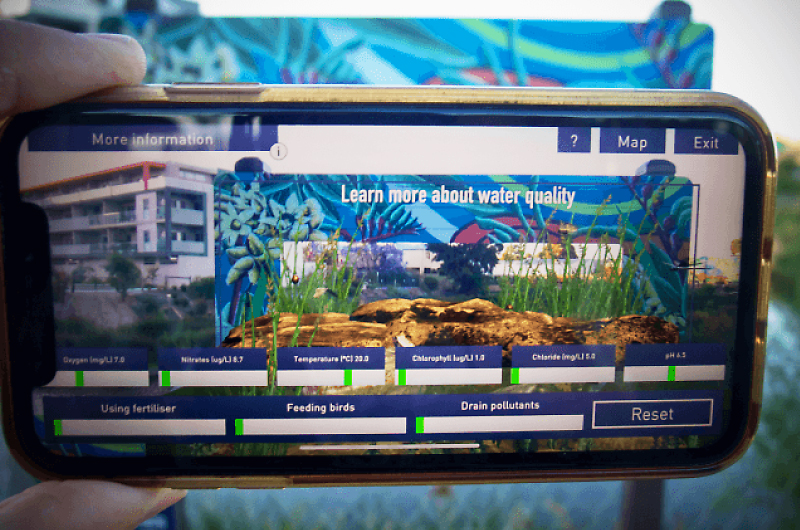 The interactive augmented reality app. Image credit: Courtney Babb, Curtin University - School of Design and the Built Environment.
The interactive augmented reality app. Image credit: Courtney Babb, Curtin University - School of Design and the Built Environment.
Planting local natives to clean up stormwater
Contaminants in stormwater basins can cause algae and low oxygen levels, making water unhealthy for fish and other organisms. To help clean the stormwater and, ultimately, the water that flows into the Canning River, we planted many local native wetland species, such as:
- Flooded Gum (Eucalyptus rudis
- Giant rush (Juncus pallidus)
- Gotu kola (Centella asiatica)
Known as a nutrient-stripping wetland, this vegetation removes excess nutrients and prevents sediment, nitrogen and phosphorus from entering the river. We also installed a water circulation system to help maintain water flow. It includes a rill – a channel that carries water from the pumping station to the wetland. This ensures the water keeps flowing.
A win for the environment and community
As well as improving local biodiversity, the space enhances amenities and liveability for local residents. It includes interactive ways for the community to learn about the urban stormwater basin's impacts on urban wetland systems and builds awareness of the cultural value of waterways to the Whadjuk Noongar people. The park also provides education and research opportunities to schools, universities and researchers.
It has transformed from a landscape managed with a higher carbon footprint due to fuel use from mowing and broad-scale herbicide treatments to one that is far less intensive, with small spot spraying the primary requirement. These changes increase the biodiversity and tree canopy across the site, providing additional shade and urban cooling benefits. Additionally, a regular maintenance cycle removes plastic pollutants that enter the stormwater system and prevents these from entering the Canning and Swan Rivers.
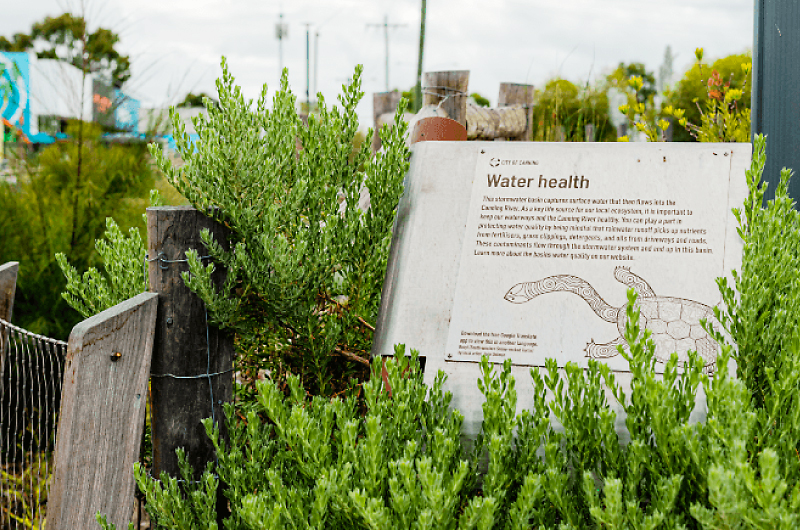
What we’re doing now
By trialling new technologies like this, we can make better decisions that improve the area's liveability, sustainability and productivity.
Water sensors improve water quality and management at Wharf St Basin. We collect data on the basin’s water quality and quantity. This helps us manage water quality and prevent algae production.
The park sets an example of how these spaces can be used in a smarter way for the community and the environment. We’re continuing to undertake Drainage for Liveability projects throughout the City, which are building on the lessons learned from this project. We’re also improving accessibility and maintenance of site data, which will facilitate water quality data management throughout the City.
The success of this collaborative project was made possible through partnerships with:
- The Australian Government’s Smart Cities Program
- Water Corporation
- Department of Water and Environmental Regulation
- Department of Biodiversity, Conservation and Attractions
- Innovation Central
- Curtin University – School of Built Environment and Design
- Urbaqa